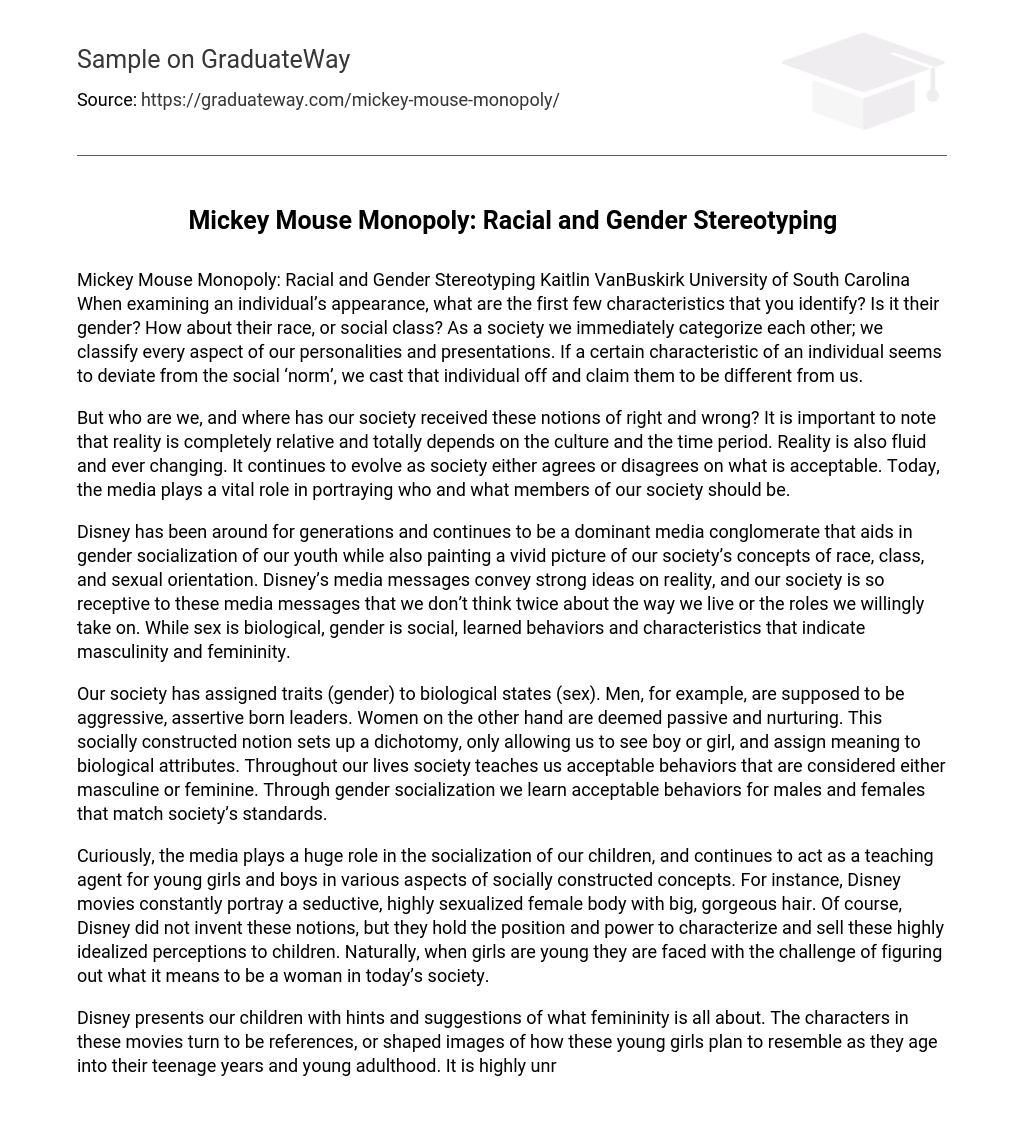When examining an individual’s appearance, what are the first few characteristics that you identify? Is it their gender? How about their race, or social class? As a society we immediately categorize each other; we classify every aspect of our personalities and presentations. If a certain characteristic of an individual seems to deviate from the social ‘norm’, we cast that individual off and claim them to be different from us. But who are we, and where has our society received these notions of right and wrong?
It is important to note that reality is completely relative and totally depends on the culture and the time period. Reality is also fluid and ever changing. It continues to evolve as society either agrees or disagrees on what is acceptable. Today, the media plays a vital role in portraying who and what members of our society should be.
Disney has been around for generations and continues to be a dominant media conglomerate that aids in gender socialization of our youth while also painting a vivid picture of our society’s concepts of race, class, and sexual orientation. Disney’s media messages convey strong ideas on reality, and our society is so receptive to these media messages that we don’t think twice about the way we live or the roles we willingly take on. While sex is biological, gender is social, learned behaviors and characteristics that indicate masculinity and femininity.
Our society has assigned traits (gender) to biological states (sex). Men, for example, are supposed to be aggressive, assertive born leaders. Women on the other hand are deemed passive and nurturing. This socially constructed notion sets up a dichotomy, only allowing us to see boy or girl, and assign meaning to biological attributes. Throughout our lives society teaches us acceptable behaviors that are considered either masculine or feminine. Through gender socialization we learn acceptable behaviors for males and females that match society’s standards.
Curiously, the media plays a huge role in the socialization of our children, and continues to act as a teaching agent for young girls and boys in various aspects of socially constructed concepts. For instance, Disney movies constantly portray a seductive, highly sexualized female body with big, gorgeous hair. Of course, Disney did not invent these notions, but they hold the position and power to characterize and sell these highly idealized perceptions to children. Naturally, when girls are young they are faced with the challenge of figuring out what it means to be a woman in today’s society.
Disney presents our children with hints and suggestions of what femininity is all about. The characters in these movies turn to be references, or shaped images of how these young girls plan to resemble as they age into their teenage years and young adulthood. It is highly unrealistic for these young ladies to expect to grow into this glorified image of a woman, but the media will keep pushing these concepts of gender socialization. As a media conglomerate, Disney holds tremendous influence on our national and international culture.
Since this corporation owns so much of the media they have the ability to exercise control over what the world sees and hears and ultimately acts out. This specific enterprise, dominated by corporate interests, has monopolized and polices the market. It controls every aspect of how it represents itself and is in a key position to sell our children whatever they wish to market. As a society, we develop our reality from the cultural mechanisms around us. We learn from everything that these billion dollar corporations give to us, and we solemnly listen to them.
They represent an authority figure to us, and we passively accept their control. Drawing on Disney as an example, it is no question that the media today gives us stereotypes of race, class, and gender. Over the years the gender depictions that Disney has portrayed seem to remain similar and constant. For example, the female figures in the films always need a male to rescue them, no matter how strong they are. One can relate that to the mentality that some women hold in our society.
Look at woman searching for a man who can finance their every need. This is a learned behavior from the media that these women have come in contact with from the days they were young. It is so important for us, as a society, to analyze institutions of the media so we can understand the role that it plays in socializing us into certain belief systems. The media in general, specifically Disney, has been around for generations and continues to be a dominant media conglomerate that aids in gender socialization of our youth.





